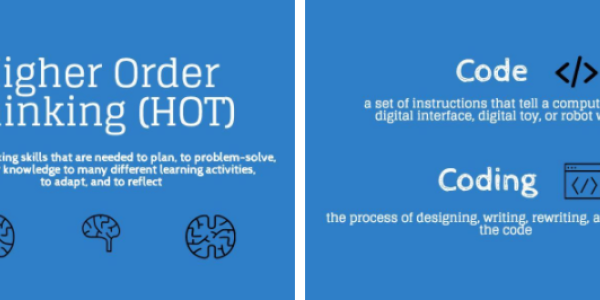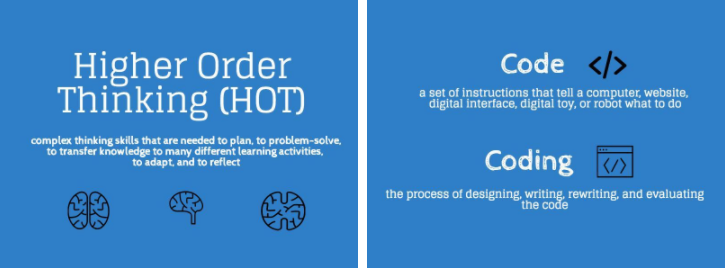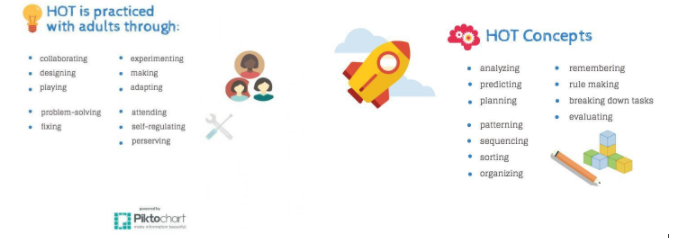The T in STEM: Creating Play-Based Experiences That Support Children’s Learning of Coding and Higher Order Thinking

From Google Creative Labs announcing their new Project Bloks research project, to tangible technology toys aimed at parents, it can feel like excitement for coding is everywhere. Coding can be engaging and fun, but it’s only meaningful when there are strong higher order thinking (HOT) foundational skills first put in place, helping young children understand the process of coding. Young children can’t create meaningful experiences through coding without these foundational skills and without adults to help support their learning.
"Developmentally appropriate practices must guide decisions about whether and when to integrate technology and interactive media into early childhood programs."
–NAEYC and Fred Rogers Center Joint Position Statement on Technology in Early Childhood (2012)

What are higher order thinking (HOT) skills?
Computational thinking (CT), higher order thinking (HOT), and executive functioning (EF) skills are phrases we see daily in education media and educational research. At their core, these skills are quite similar because they help us reason, think critically, and problem solve. They develop at different rates for children depending on context and exposure to play and learning experiences that support their development. Play experiences like problem-solving, collaborating and designing during their playing and making are powerful experiences that all children need to be successful in life, to innovate, and to learn how to think through complex problems, such as coding. The adults in a young child’s life play a critical role as mentors, role models, and facilitators to help young children learn these skills through their use of language and their behavior. For this blog post, I will use the term higher order thinking (HOT) to refer to these combined skills.

For infants and toddlers, responsive interactions between adults and children are essential to early brain development and to cognitive, social, emotional, physical, and linguistic development.
–NAEYC and Fred Rogers Center College Joint Position Statement on Technology in Early Childhood (2012)
Early childhood educators have long helped young children hone their HOT skills through play-based experiences. Now there is a call from researchers and many others to deepen HOT skills in early childhood by introducing technology tools and coding when appropriate. We are just starting to put these ideas into practice in early childhood settings, and we are learning right along with the children, families, and educators we support.
It is a very exciting time in the world of education, young children, and technology, but it can also feel overwhelming if you are trying to figure out how to get started in your classroom. Before we introduce technology tools to use for coding, let's first get started practicing our HOT and coding muscles with children in our classroom.
Developmentally appropriate teaching practices must always guide the selection of any classroom materials, including technology and interactive media.
–NAEYC and Fred Rogers Center College Joint Position Statement on Technology in Early Childhood (2012)
Five tips to get started practicing HOT and early coding foundational skills without any technology:
-
Block play
Set up a variety of colored and shaped blocks where children can easily create and identify patterns with you. As children master the pattern and sequence making, you can collaborate to create more complex patterns and sequences that act as secret codes that children and adults have to analyze and problem-solve together to decode the pattern and sequence.
Ask children to design and draw, and build something. Have the children pick the idea they will build as a group. Help children collaborate to make a building plan in order to execute their idea. Facilitate the children by assigning roles to make their creation and sort and organize their supplies. As they build, model and ask children to problem-solve, fix, and use directional language (right, left, down, up, under, over, etc.). Consider taking photographs of the building process and use these visuals to support children's reflection and evaluation of the process.
-
Read-alouds
Have children look for and identify patterns in the books you are reading. Look for opportunities to count together, predict what will happen next in the story, and identify where characters have to problem-solve or adapt what they are doing.
-
Storytelling
Have children work in groups to collaborate and write a story with you. Have some prompts ready to help children develop a plan for the characters; create a story with a beginning, middle, and end; and use directional and sequential language.
With one group of children, cut up different pictures and sentences from their story and have another group of children collaborate to put the story back together in sequential order. This is also a great activity to do with familiar fairy tales or favorite stories you have been reading together regularly.
-
Art
Have children design and draw directional arrows and stop and go symbols with you on colored index cards. Use the same colors for each type of directional arrow (i.e. yellow for left). You can either give children a set of index cards for numbers 1–10 or have the children make them on their own.
-
Game design
Have children draw a map on grid paper for a “robot” to follow using their directional arrows and symbols (from the art activity above) as guides. Have the children count each square so they can tell their “robot” how many steps to take with each direction and have the children add those numbers to their plan. Then have children pair up and take turns pretending to be the “robot” while their partner practices giving them directions using the index cards. Facilitate children fixing, problem-solving, and evaluating to develop a set of sequential instructions (i.e. a code that their partners can follow.)
Here are some resources to use as you look for classroom activities to support HOT and coding skills:
TEC Center at Erikson Institute: teccenter.erikson.edu
Early Math Collaborative Ideas Library at Erikson Institute: http://earlymath.erikson.edu/ideas/
Association of Libraries Services for Children blog, STEM/STEM Section: http://www.alsc.ala.org/blog/category/stemsteam/
Here is some research on higher order thinking, executive functioning, and computational thinking skills in early childhood:
Bernier, A., S.M. Carlson, M. Deschênes, & C. Matte-Gagne. 2012. “Social Precursors of Preschoolers’ Executive Functioning: A Closer Look at the Early Caregiving Environment.” Developmental Science 15: 12–24.
Bers, M.U., L.P. Flannery, E.R. Kazakoff, & A. Sullivan. 2014. ”Computational Thinking and Tinkering: Exploration of an Early Childhood Robotics Curriculum.” Computers & Education 72: 145–57.
Verdine, B.N., K.R. Lucca, R.M. Golinkoff, N.S. Newcombe, & K. Hirsh-Pasek. 2015. “The Shape of Things: The Origin of Young Children’s Knowledge of the Names and Properties of Geometric Forms.” Journal of Cognition and Development 12: 315–31.
Wing, J. 2006. “Computational Thinking.” Communications of the ACM 49 (3): 33–6.
Tamara Kaldor, M.S., is the Assistant Director, TEC Center at Erikson Institute.